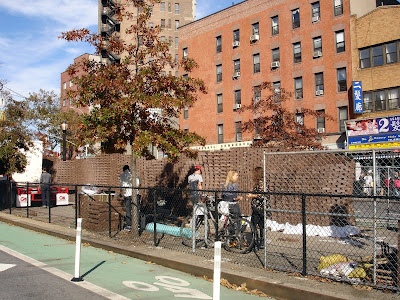A Swiss robot (named R-O-B) has finished building a brick wall on Pike Street, New York. According to Storefront, this is the first ever architecture project digitally fabricated on site. The design was developed through Gramazio & Kohler's research on architecture and digital fabrication (DFab), which was initially established at ETH Zurich, Faculty of Architecture in 2005.
Watching R-O-B in action is exciting -
 The robot is mounted on a lowbed trailer. It slides along the construction site through the process.
The robot is mounted on a lowbed trailer. It slides along the construction site through the process. It picks up a brick from the belt and puts on some glue...
It picks up a brick from the belt and puts on some glue... then moves out...
then moves out... and gently lays down the brick in the precise position.
and gently lays down the brick in the precise position. The result is a 22m-long structure built from more than 7,000 bricks. The weaving form loops in and out in changing rhythms, lifting off the ground sometimes and intersecting with itself.
The result is a 22m-long structure built from more than 7,000 bricks. The weaving form loops in and out in changing rhythms, lifting off the ground sometimes and intersecting with itself.





I don't want to sound dismissive of new technology, which is in fact fascinating. But at the same time, I also have some doubts:
- Integration of design and fabrication: We all more or less design digitally now. But the highly acclaimed digital designs often ended up as clumsy plaster works. (Need an example?) The marriage of design and construction is a big challenge. R-O-B certainly opens up a whole new array of possibilities. At least it's way cooler than the current BIM hype that made the ugly Yankee Stadium "Best Project of the Year in New York."
- Accuracy: If you want a complex geometry (yeah, if you really need it), it would be hard to make it manually. CNC processes can make sure the outcome is precisely what you want. But with this brick wall, is on-site digital fabrication really "the only way" it can be achieved? OK, perhaps I should accept the fact that patience and craftsmanship are long lost legends...
- Strength: The industrial robot unit is powerful. Lifting bricks? Why use an ox cleaver to kill a chicken?
- Speed: The whole process took 4 weeks. I am not sure how that compares to conventional brick wall builders.
- Labor: And we do need labor after all. Controlling the machine, feeding the belt with bricks, and taking care of the built part, at least three people were working on site. I am not talking about how many people were behind the scene programming and writing scripts. After the robot was done, they still need to remove some bricks at the bottom since the design asks for some suspended sections. I guess you just can't ignore the law of gravity when you lay brick walls.
When talking with Michael the project leader and Cesar the producer, I learned some making-of stories. DFab is actually quite done with brick now. They have built several brick walls since 2006 and have already moved on to many other materials and techniques such as structural wood, drilling holes in concrete, and spraying foam. However, for this project, the mobile robot unit was borrowed from one of the sponsors Keller AG Ziegeleien. It is a brick company so the material would be free too. Suddenly the answer to my doubts became clear. It's not that DFab hasn't fully recognized the great potential of R-O-B, but just everything comes down to power and money. It's the reality of getting things done. Most architects choose not to talk about it, and schools never taught that either. Students just sit in front of the computer and play with Grasshopper. Parametric design has neglected one very important parameter - money. Maybe we need a software that allows you to slide a "budget bar" and your model will automatically change form and material...

No comments:
Post a Comment